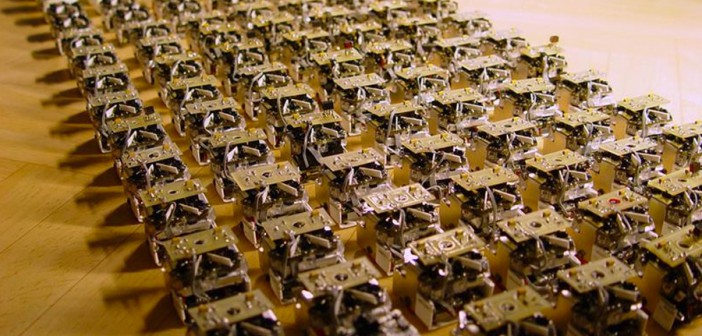We’re on the edge of inventing a new form of expression between humans and machines, says Russell Davies.
I’m talking at the APG Annual Conference in a couple of months. Its theme is “strategy vs robots” so I’ve been thinking about robots and wondering what to say.
This is normally what we mean by “robots”:
I made this at a robot trade fair in Lyon in 2011, organised by SYROBO, the French Federation of Service Robotics. Go to this year’s fair and it won’t be that different. It’ll be bigger, the robots will do a lot more stuff, but they’ll look pretty much the same: either industrial, humanoid or swarmy. Maybe you’ll see something like Spot – or like these tiny bugs pulling a car – but you won’t see anything you’d mistake for a person. That’s just because software gets better much quicker than hardware, so the physical stuff of robots progresses a bit slower.
That’s why a lot of the really fast moving stuff is happening away from the hardware, in the way they talk to us and we talk to them. After all, when you talk to Siri or Amazon Echo you’re talking to a small computer connected to a network connected to a much bigger computer. There’s no reason that small computer couldn’t be in a robot. Here, for instance, is a prototype of a voice controlled Roomba.
This is the stuff that fascinates me, because it seems to be an emerging creative skill set. It’s something that people who make products and services are going to have to think about. Your domestic stuff is going to talk to you. How should it do it? How robotic should it be? How jokey? How serious? Should your fridge know what to do if you tell it you’re being abused? Cars are starting to talk to people – manufacturers have been thinking about that in fiction and reality for decades – but what should a VW sound like? What about a BMW or a Bentley?
As soon as you start to think about this a couple of things crop up:
-
What’s the relationship between the object and the voice?
Should it be small object, small voice? What’s the mental model we’re carrying around about these things? One thing that’s immediately apparent – we’re very happy to believe, or at least behave like we believe, that these things are alive. The tiniest hint of movement or agency and we assume that there’s some sort of animated spirit in there. I explored that once with a Robert Frost poem:
That robot is a Sony Rolly, a spin-off from their abandoned Aibo robotic pet project. The Rolly was also abandoned. It was hugely expensive and didn’t do much – you could programme it to roll around a bit and flap its arms (or legs or whatever they are).
But, as you can see, stick a bit of speech in there, do some really basic programming, and you kinda believe that a dark and meditative poet of the rural and colloquial has been reborn as a piece of robotic Japanese whimsy.
My favourite illustration of this is the KeepOn, originally designed to understand how to forge relationships between children and robots, then turned into toy, then an advertising campaign. (I used to show this video a lot at advertising conferences, I wonder if the EDF thing is my fault? Sorry about that.) KeepOn’s genius is that it doesn’t try too hard – it only requires a minimal face, minimal interaction and minimal movement and you immediately like it and want to interact.
-
How much of the voice do you script and how much do you programme?
The stuff that’s really getting faster all the time is Artificial Intelligence (in all its different flavours and versions) – computers are getting good at talking to us like they understand. Thus we no longer have to script them like a voicemail system (when X happens say Y) – they can be given a range of responses to choose from and, to some extent, be allowed to learn or make up the right thing to say.
Computers are already writing news stories based on data feeds, and they’re starting to read them out. And then we’ll have self checkout machines that don’t just use the same few canned phrases – they’ll start to talk to us about our shopping and how many loyalty points we have available. THIS IS GOING TO BE AWFUL. Or at least it’ll be awful for a long, long time, until someone gets it right.
I tried experimenting with this stuff a few years ago and made ScienceStoryMagic, an imaginary service providing news and lifestyle updates based on what it knew about your consumer preferences. It got dystopic pretty quickly.
But I think it proves the thing that gets me really excited about this stuff – we’re on the edge of inventing a new way to do writing, a new kind of expression, a collaboration between writers and algorithms. The natural endpoint of this isn’t a machine that talks exactly like a human, it’s a machine that talks exactly like a machine – but one that’s worth having a relationship with. And there are some people out there with exactly the skills to do this, people who can use words but not be precious about them, people who can write on behalf of abstract entities, who can find exactly the right small phrase for the right big feeling. Copywriters – we might have a future!
Anyway, I suspect the APG haven’t lined up Steve Hilton and Kate Fox to talk about BigDog‘s potential as an advertising vehicle, they mean “robots” in a wider sense – algos, software eating our jobs, all that kind of stuff. So you should come along – I’ll bring a robot.
This article was first published on campaignlive.co.uk




